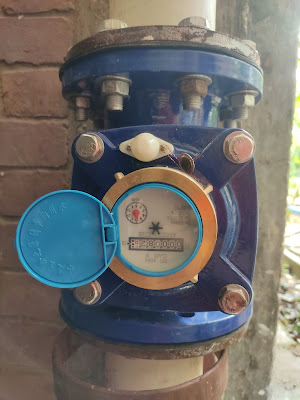Rainwater harvesting is becoming an essential solution in addressing water scarcity and promoting sustainable water management. At CRP, Savar, the rainwater harvesting project aims to conserve water by collecting and storing rainwater for future use. To ensure efficient operation and track water usage, it is crucial to install a flow meter to measure the flow of rainwater through the discharge pipe of the system. Here’s how you can successfully install a flow meter and optimize the rainwater harvesting system.
Why Install a Flow Meter?
A flow meter is a critical component in monitoring the performance of a rainwater harvesting system. It provides accurate measurements of the volume of water passing through the discharge pipe, allowing us to:
- Monitor system efficiency: Track how much rainwater is being collected and used.
- Detect leaks: Identify any unusual flow rates that may indicate leakage or system malfunction.
- Manage water resources: Ensure optimal use of harvested water by understanding consumption patterns.
- Comply with regulations: In some areas, monitoring water usage may be required by local authorities for environmental reporting or permits.
 |
Flow Meter |
Step-by-Step Guide to Installing a Flow Meter
1. Choose the Right Flow Meter
The first step in the installation process is selecting the right type of flow meter for your rainwater harvesting system. Since rainwater tends to be clean but may carry some debris, a turbine flow meter or ultrasonic flow meter would be suitable. These types of meters can handle varying flow rates and are relatively easy to maintain.
2. Select the Ideal Location
Place the flow meter on the discharge pipe where it will measure the flow rate of rainwater as it leaves the storage tank. Ensure that:
- The pipe is straight before and after the installation point to prevent turbulence, which may affect accuracy.
- The flow meter is installed in a horizontal section of the pipe to ensure steady flow.
- The location is easily accessible for future maintenance and monitoring.
 |
Selecting the ideal location for flow meter |
3. Prepare the Discharge Pipe
Before installation, turn off any water supply to the system to avoid interruptions or hazards. Next, cut the discharge pipe at the selected location. Ensure that the pipe’s ends are smooth and clean to avoid interference with the flow readings.
4. Install the Flow Meter
Carefully install the flow meter according to the manufacturer’s instructions. This typically involves:
- Attaching the meter to the pipe with appropriate fittings (flanges or compression fittings).
- Ensuring the flow direction indicated on the meter aligns with the flow of water.
- Tightening all connections to prevent leaks but avoiding over-tightening, which can damage the meter.
5. Connect Electrical Components (if applicable)
Some flow meters, such as ultrasonic models, require an electrical connection for power and data transmission. Follow the wiring diagram provided in the installation manual to connect the meter to its power source and data logger.
6. Calibrate the Flow Meter
After installation, calibrate the flow meter to ensure it provides accurate readings. You may need to follow the specific calibration process detailed in the manufacturer’s guidelines, which could include adjusting settings for the type of fluid (rainwater) and the expected flow range.
7. Test the System
Once everything is in place, turn the water supply back on and test the flow meter. Check for any leaks around the connections and ensure that the meter is reading the flow accurately. Compare the readings with manual calculations to confirm precision.
Ongoing Monitoring and Maintenance
Regularly monitor the flow meter to ensure it continues functioning properly. Keep the discharge pipe and the meter clean and free from blockages caused by debris, which can skew readings. Periodically recalibrate the meter if required, especially after extended use or system maintenance.
Benefits of Flow Meter Installation at CRP, Savar
By installing a flow meter in the rainwater harvesting system at CRP, Savar, we can track and analyze the amount of rainwater being harvested, stored, and used efficiently. This helps in:
- Sustainable water management by understanding peak water usage times.
- Reducing water wastage by detecting leaks or inefficient usage.
- Optimizing system performance, ensuring that collected rainwater is put to the best use.
This small but essential step helps us move towards sustainable resource management while contributing to CRP’s commitment to environmental responsibility.
Conclusion
Flow meters play a pivotal role in rainwater harvesting systems by providing valuable data on water flow and usage. Installing one at the CRP, Savar, ensures that we maximize the efficiency of the rainwater harvesting project, paving the way for a greener, more sustainable future.
Author












0 Comments